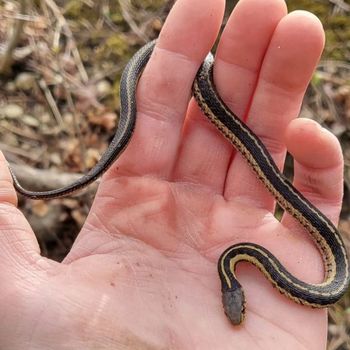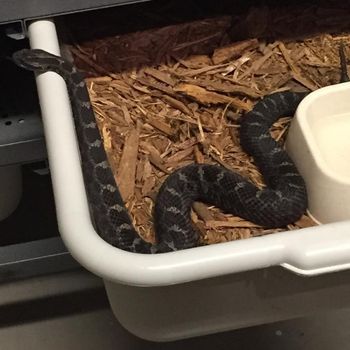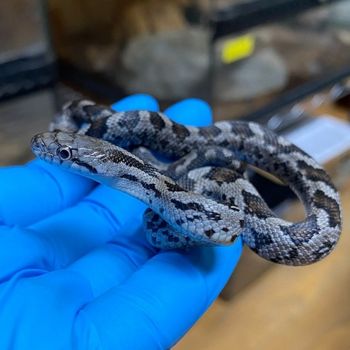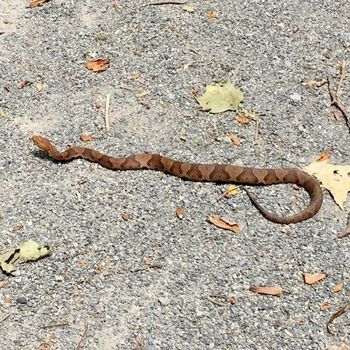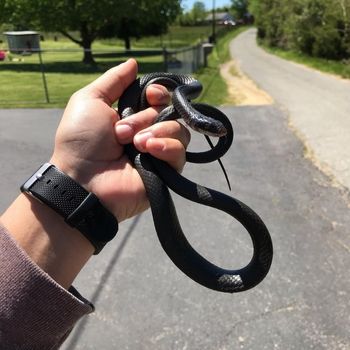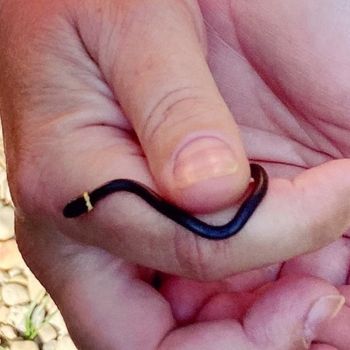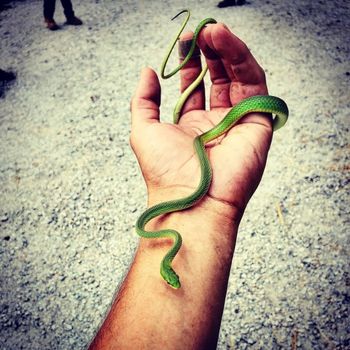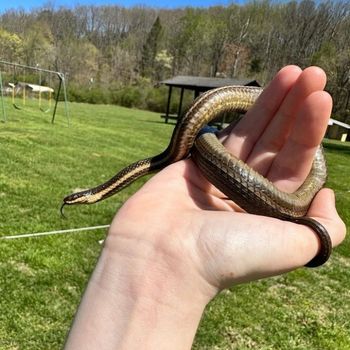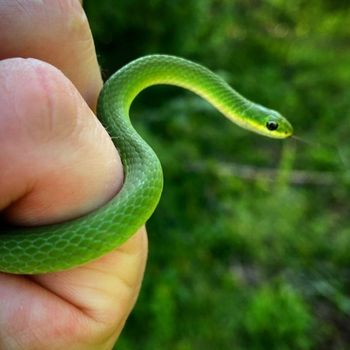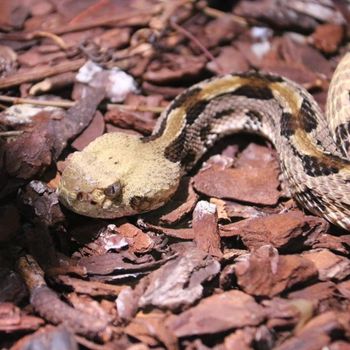Snakes in Pennsylvania: Keystone Snake Mysteries
Did you know that Pennsylvania is actually home to quite a diverse variety of slithery species? Although it may not seem like a snake haven, around 14 different species call the Keystone State their home.
From harmless garden snakes to venomous pit vipers, our beautiful state has a broad collection of these fascinating creatures. Whether you love them or are simply curious, it’s interesting to learn about the different snakes we might encounter!
So, with that in mind, let’s dive into the scaly world of Pennsylvania’s slithering residents and explore the diverse range of snakes you can find right in our own backyards.
| # | Name | Details | Image |
| 1 | Eastern Garter Snake (Thamnophis sirtalis sirtalis) |
| 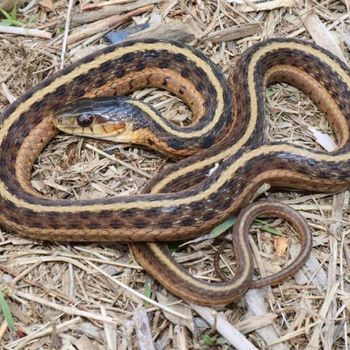 |
| 2 | Eastern Massasauga (Sistrurus catenatus) |
| 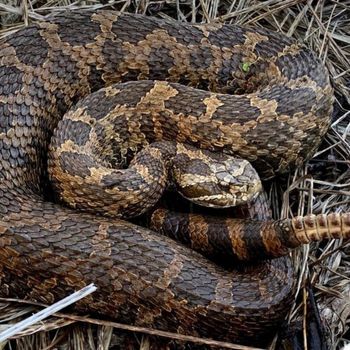 |
| 3 | Eastern Milksnake (Lampropeltis triangulum) |
|  |
| 4 | Eastern Rat Snake (Pantherophis alleghaniensis) |
| 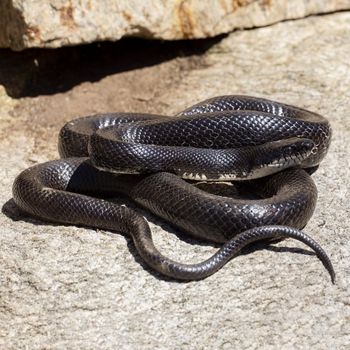 |
| 5 | Eastern Worm Snake (Carphophis amoenus amoenus) |
| 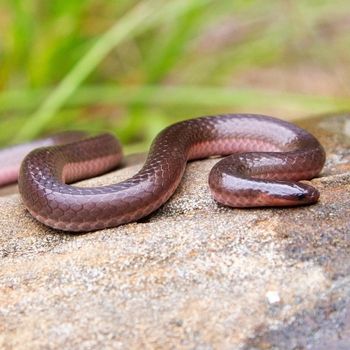 |
| 6 | Kirtland’s Snake (Clonophis kirtlandii) |
| 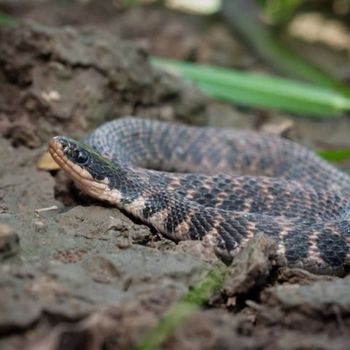 |
| 7 | Northern Copperhead (Agkistrodon contortrix mokasen) |
| 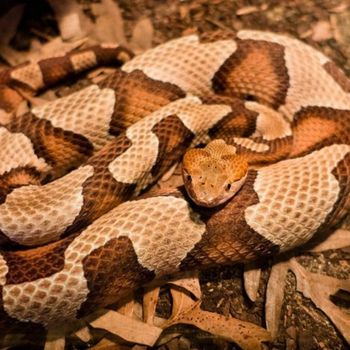 |
| 8 | Northern Racer (Coluber constrictor) |
| 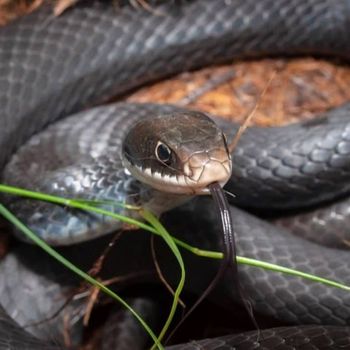 |
| 9 | Northern Ringneck Snake (Diadophis punctatus edwardsii) |
| 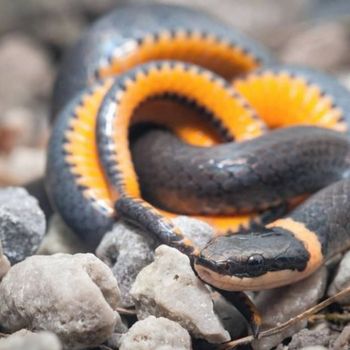 |
| 10 | Northern Rough Green Snake (Opheodrys aestivus) |
|  |
| 11 | Northern Water Snake (Nerodia sipedon) |
|  |
| 12 | Queen Snake (Regina septemvittata) |
| 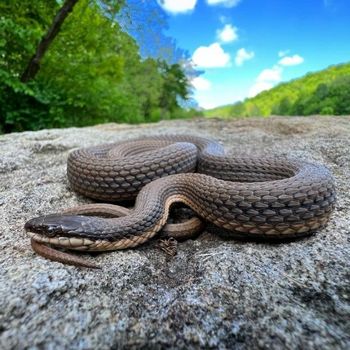 |
| 13 | Smooth Green Snake (Opheodrys vernalis) |
| 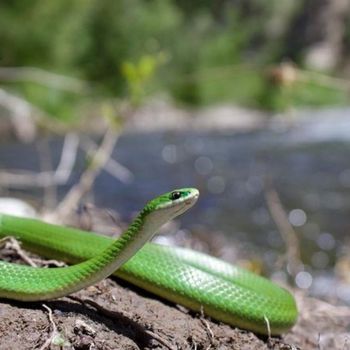 |
| 14 | Timber Rattlesnake (Crotalus horridus) |
|  |
14 Snakes You Can Find in Pennsylvania
In the state of Pennsylvania, a fascinating array of serpents can be found slithering through its diverse landscapes. From venomous to harmless, each species has its unique story to tell. Below, we’ll explore the wonders of these often misunderstood creatures of Pennsylvania, from their natural habitats and behaviors to the challenges they face in our changing world.
1. Eastern Garter Snake
- Scientific Name: Thamnophis sirtalis sirtalis
- Common Name: Eastern garter snake
- Size: Up to 2-4.5 feet (0.6-1.4 meters)
- Natural Habitat: Forests, grasslands, wetlands, and urban areas
- Color: Brown, green or gray with three yellow stripes
- Habitat: Forests, grasslands, wetlands, and urban areas
- Maximum Size: Up to 2-4.5 feet (0.6-1.4 meters)
- Diet: Earthworms, amphibians, fish, and small mammals
- Reproduction: Lay eggs in clutches of 10-40
- Venom: Mildly venomous but harmless to humans
- Conservation: Least concern
The Eastern Garter Snake (Thamnophis sirtalis sirtalis) is a commonly found snake species that can grow up to 2-4.5 feet (0.6-1.4 meters) in length. It displays a brown, green, or gray coloration adorned with three yellow stripes. Inhabitants of forests, grasslands, wetlands and urban areas, these diurnal and terrestrial reptiles primarily feed on earthworms, amphibians, fish, and small mammals. Eastern Garter Snakes reproduce by laying 10-40 eggs per clutch, and although they are mildly venomous, their venom poses little risk to humans. They are currently classified under the least concern category in conservation status.
2. Eastern Massasauga
- Scientific Name: Sistrurus catenatus
- Common Name: Eastern massasauga
- Size: 18-30 inches (45-76 cm)
- Natural Habitat: Wetlands, grasslands, and forests
- Color: Gray or light brown with dark brown blotches
- Habitat: Wetlands, grasslands, and forests
- Maximum Size: 18-30 inches (45-76 cm)
- Diet: Small mammals, amphibians, and occasionally birds
- Reproduction: Give live birth to 5-20 young
- Venom: Venomous, but rarely fatal
- Conservation: Threatened
The Eastern Massasauga (Sistrurus catenatus), a gray or light brown rattlesnake with dark brown blotches, measures 18-30 inches (45-76 cm) in length. Found in wetlands, grasslands, and forests, it is solitary and adapts its behavior with temperatureódiurnal during cooler months and crepuscular or nocturnal in warmer months. Its diet consists of small mammals, amphibians, and sometimes birds. The snake reproduces by giving live birth to 5-20 offspring. While venomous, its bite is rarely fatal. It is currently considered a threatened species.
3. Eastern Milksnake
- Scientific Name: Lampropeltis triangulum
- Common Name: Eastern milksnake
- Size: Up to 3.9 feet (1.2 meters)
- Natural Habitat: Forests, grasslands, farmlands, and rocky areas
- Color: Reddish-brown with y-shaped black-edged white bands
- Habitat: Forests, grasslands, farmlands, and rocky areas
- Maximum Size: Up to 3.9 feet (1.2 meters)
- Diet: Rodents, small birds, and reptiles
- Reproduction: Lay eggs in clutches of 3-20
- Venom: Non-venomous
- Conservation: Least concern
The Eastern Milksnake (Lampropeltis triangulum) is a non-venomous snake that grows up to 3.9 feet (1.2 meters) in length. It features a reddish-brown color adorned with Y-shaped black-edged white bands. Commonly found in forests, grasslands, farmlands, and rocky areas of Pennsylvania, this nocturnal and terrestrial snake primarily consumes rodents, small birds, and reptiles. Eastern Milksnakes reproduce by laying egg clutches of 3-20. Currently, their conservation status is listed as least concern.
4. Eastern Rat Snake
- Scientific Name: Pantherophis alleghaniensis
- Common Name: Eastern rat snake
- Size: Up to 7 feet (2.1 meters)
- Natural Habitat: Forests, meadows, wetlands, and urban areas
- Color: Black or dark gray with pale gray, tan, or yellow
- Habitat: Forests, meadows, wetlands, and urban areas
- Maximum Size: Up to 7 feet (2.1 meters)
- Diet: Rodents, birds, and bird eggs
- Reproduction: Lay eggs in clutches of 5-27
- Venom: Non-venomous
- Conservation: Least concern
The Eastern Rat Snake (Pantherophis alleghaniensis) is a large, non-venomous reptile that can reach 7 feet (2.1 meters) in length. They have a black or dark gray color with patches of pale gray, tan, or yellow. Found in forests, meadows, wetlands, and urban areas, these semi-arboreal snakes have diurnal or nocturnal behavior depending on temperature. Their diet consists of rodents, birds, and bird eggs. Eastern Rat Snakes reproduce by laying eggs in clutches of 5-27 and have a conservation status marked as “Least Concern.”
5. Eastern Worm Snake
- Scientific Name: Carphophis amoenus amoenus
- Common Name: Eastern worm snake
- Size: Up to 11-14 inches (28-35.5 centimeters)
- Natural Habitat: Forests, woodlands, and grasslands with moist soil
- Color: Pink-brown to gray-brown with a pinkish-yellow belly
- Habitat: Forests, woodlands, and grasslands with moist soil
- Maximum Size: Up to 11-14 inches (28-35.5 centimeters)
- Diet: Earthworms and other soft-bodied invertebrates
- Reproduction: Lay eggs in clutches of 2-8
- Venom: Non-venomous
- Conservation: Least concern
The Eastern Worm Snake (Carphophis amoenus amoenus) is a small, non-venomous species, reaching lengths of 11-14 inches (28-35.5 centimeters). It possesses a pink-brown to gray-brown coloration with a distinctive pinkish-yellow belly. This elusive, nocturnal burrower inhabits forests, woodlands, and grasslands with moist soil. Its diet primarily consists of earthworms and other soft-bodied invertebrates. The Eastern Worm Snake lays egg clutches of 2-8 eggs, and its conservation status is currently listed as “Least Concern.”
6. Kirtland’s Snake
- Scientific Name: Clonophis kirtlandii
- Common Name: Kirtland’s snake
- Size: Up to 24 inches (60 centimeters)
- Natural Habitat: Wet meadows, prairies, marshes, and woodland edges
- Color: Gray or brown with red or orange belly and black spots
- Habitat: Wet meadows, prairies, marshes, and woodland edges
- Maximum Size: Up to 24 inches (60 centimeters)
- Diet: Earthworms, slugs, and snails
- Reproduction: Oviparous, laying clutches of about 3-11 eggs in late spring or early summer
- Venom: Non-venomous
- Conservation: Near threatened
Kirtland’s Snake (Clonophis kirtlandii) is a non-venomous reptile that grows up to 24 inches in length. It has a gray or brown coloration with a red or orange belly adorned with black spots. This secretive, burrowing snake thrives in habitats such as wet meadows, prairies, marshes, and woodland edges. Primarily feeding on earthworms, slugs, and snails, Kirtland’s Snake is oviparous, laying clutches of 3-11 eggs during late spring or early summer. Currently, it holds a “near threatened” conservation status.
7. Northern Copperhead
- Scientific Name: Agkistrodon contortrix mokasen
- Common Name: Northern copperhead
- Size: 24 to 36 inches (61 to 91 centimeters), sometimes reaching 4 feet (1.2 meters)
- Natural Habitat: Deciduous forests, mixed woodlands, rocky areas, and near streams
- Color: Copper-colored with dark brown bands
- Habitat: Deciduous forests, mixed woodlands, rocky areas, and near streams
- Maximum Size: 24 to 36 inches (61 to 91 centimeters), sometimes reaching 4 feet (1.2 meters)
- Diet: Small mammals, birds, amphibians, and reptiles
- Reproduction: Give birth to live young, 4-14 offspring per litter
- Venom: Venomous, but usually not fatal to humans
- Conservation: Least concern
The Northern Copperhead (Agkistrodon contortrix mokasen) is a venomous snake found in deciduous forests, mixed woodlands, rocky areas, and near streams. It measures 24 to 36 inches (61 to 91 cm) in length, occasionally reaching 4 feet (1.2 meters). Copperheads are copper-colored and have dark brown bands on their bodies. These crepuscular ambush predators primarily prey on small mammals, birds, amphibians, and reptiles. They reproduce by giving birth to live young, with 4-14 offspring per litter. Though venomous, their bites are usually not fatal to humans. Their conservation status is currently classified as “least concern.”
8. Northern Racer
- Scientific Name: Coluber constrictor
- Common Name: Northern racer
- Size: Up to 4.5 feet (1.37 meters)
- Natural Habitat: Various habitats, including woodlands, grasslands, and wetlands
- Color: Gray, brown or blue with a lighter underbelly
- Habitat: Various habitats, including woodlands, grasslands, and wetlands
- Maximum Size: Up to 4.5 feet (1.37 meters)
- Diet: Rodents, small birds, lizards, and amphibians
- Reproduction: Lay eggs in clutches of 5-30
- Venom: Non-venomous
- Conservation: Least concern
The Northern Racer (Coluber constrictor) is a non-venomous snake species known for its agile movements and excellent climbing abilities. Reaching up to 4.5 feet (1.37 meters) in length, these snakes display a range of coloration including gray, brown, or blue, with a lighter underbelly. Preferring a diurnal lifestyle, they inhabit various ecosystems such as woodlands, grasslands, and wetlands. Their diet consists of rodents, small birds, lizards, and amphibians. Reproduction occurs through egg-laying, producing clutches of 5-30 eggs. Their conservation status remains of least concern.
9. Northern Ringneck Snake
- Scientific Name: Diadophis punctatus edwardsii
- Common Name: Northern ringneck snake
- Size: 12-15 inches, rarely up to 24 inches
- Natural Habitat: Woodlands, rock outcrops, and grasslands
- Color: Gray or black with a distinctive yellow or orange ring around the neck
- Habitat: Woodlands, rock outcrops, and grasslands
- Maximum Size: 12-15 inches, rarely up to 24 inches
- Diet: Small invertebrates, slugs, earthworms, and small amphibians
- Reproduction: Lay eggs in clutches of 3-10
- Venom: Mildly venomous, but harmless to humans
- Conservation: Least concern
The Northern Ringneck Snake (Diadophis punctatus edwardsii) is a small, mildly venomous snake native to North America, measuring 12-15 inches in length, rarely reaching up to 24 inches. Its body color varies from gray to black and features a distinctive yellow or orange ring around its neck. The species inhabits woodlands, rock outcrops, and grasslands, exhibiting nocturnal, secretive, and terrestrial behavior. Its diet consists of small invertebrates, slugs, earthworms, and small amphibians. These snakes reproduce by laying egg clutches of 3-10 and pose no threat to humans. Their conservation status is listed as least concern.
10. Northern Rough Green Snake
- Scientific Name: Opheodrys aestivus
- Common Name: Northern rough green snake
- Size: Up to 45 inches (1.1 meters)
- Natural Habitat: Found in open forests, meadows, and bushy areas near water
- Color: Bright green with a yellowish-white belly
- Habitat: Found in open forests, meadows, and bushy areas near water
- Maximum Size: Up to 45 inches (1.1 meters)
- Diet: Insects, spiders, and small amphibians
- Reproduction: Lay eggs in clutches of 2-14
- Venom: Non-venomous
- Conservation: Least concern
The Northern Rough Green Snake (Opheodrys aestivus) is a non-venomous, brightly colored reptile reaching up to 45 inches (1.1 meters) in length. Its vibrant green back complements its yellowish-white belly perfectly. These arboreal, diurnal snakes can be found in open forests, meadows, and bushy areas near water sources, such as streams and rivers. They primarily feed on insects, spiders, and small amphibians. Females lay clutches of 2-14 eggs during reproduction. Currently, their conservation status is categorized as least concern.
11. Northern Water Snake
- Scientific Name: Nerodia sipedon
- Common Name: Northern water snake
- Size: Up to 4.5 feet (1.4 meters)
- Natural Habitat: Aquatic habitats, such as rivers, lakes, ponds, and marshes
- Color: Brown or gray with dark bands or blotches
- Habitat: Aquatic habitats, such as rivers, lakes, ponds, and marshes
- Maximum Size: Up to 4.5 feet (1.4 meters)
- Diet: Fish, amphibians, and invertebrates
- Reproduction: Lay eggs in clutches of 10-30
- Venom: Non-venomous
- Conservation: Least concern
The Northern Water Snake (Nerodia sipedon) is a non-venomous reptile that can grow up to 4.5 feet (1.4 meters) in length. It is characterized by its brown or gray color with dark bands or blotches. This nocturnal and semi-aquatic species can be found in a variety of aquatic habitats, including rivers, lakes, ponds, and marshes. Its diet consists of fish, amphibians, and invertebrates. Northern Water Snakes reproduce by laying eggs in clutches of 10-30, and currently have a conservation status of least concern.
12. Queen Snake
- Scientific Name: Regina septemvittata
- Common Name: Queen snake
- Size: Up to 3 feet (0.9 meters)
- Natural Habitat: Streams, creeks, and other aquatic environments
- Color: Olive, brown or gray with three stripes and cream or yellowish belly
- Habitat: Streams, creeks, and other aquatic environments
- Maximum Size: Up to 3 feet (0.9 meters)
- Diet: Crayfish and other small aquatic invertebrates
- Reproduction: Lay eggs in clutches of 4-14
- Venom: Non-venomous
- Conservation: Least concern
The Queen Snake (Regina septemvittata) is a non-venomous reptile growing up to 3 feet (0.9 meters) in length. Often sporting olive, brown, or gray coloration, this snake displays three distinctive stripes and a yellowish belly. It thrives in aquatic habitats such as streams and creeks, and is highly active during the day. Queen Snakes primarily feed on crayfish and other small aquatic invertebrates. They lay eggs in clutches of 4-14, and currently face no significant conservation threats.
13. Smooth Green Snake
- Scientific Name: Opheodrys vernalis
- Common Name: Smooth green snake
- Size: 14-20 inches (36-51 cm)
- Natural Habitat: Grasslands, meadows, and open woodlands
- Color: Bright green with a lighter belly
- Habitat: Grasslands, meadows, and open woodlands
- Maximum Size: 14-20 inches (36-51 cm)
- Diet: Insects and spiders
- Reproduction: Lay eggs in clutches of 3-12
- Venom: Non-venomous
- Conservation: Least concern
The Smooth Green Snake (Opheodrys vernalis) measures 14-20 inches (36-51 cm) and is characterized by its vibrant green color and lighter belly. Commonly found in grasslands, meadows, and open woodlands, this diurnal and terrestrial reptile is an adept climber. Its diet mainly consists of insects and spiders. In terms of reproduction, they lay eggs in clutches of 3-12. Though non-venomous, these snakes should be admired from afar. Fortunately, their conservation status is currently listed as ‘Least Concern.’
14. Timber Rattlesnake
- Scientific Name: Crotalus horridus
- Common Name: Timber rattlesnake
- Size: Up to 6 feet (1.8 meters)
- Natural Habitat: Forests, mixed woodlands, and rocky hillsides
- Color: Yellow, brown, gray, or black with dark bands
- Habitat: Forests, mixed woodlands, and rocky hillsides
- Maximum Size: Up to 6 feet (1.8 meters)
- Diet: Rodents, birds, and small mammals
- Reproduction: Viviparous, giving birth to 4-14 live young
- Venom: Hemotoxic venom
- Conservation: Least concern
The Timber Rattlesnake, scientifically known as Crotalus horridus, is a solitary, ambush predator that can grow up to 6 feet (1.8 meters) in length. It comes in various colors, including yellow, brown, gray, or black with dark bands, and inhabits forests, mixed woodlands, and rocky hillsides. Its diet consists of rodents, birds, and small mammals. Unlike most snakes, the Timber Rattlesnake is viviparous, giving birth to 4-14 live young. It possesses hemotoxic venom, and its conservation status is currently listed as least concern.
Nearby States:
Final Words
All the 14 snakes have truly opened our eyes to the fascinating world of snakes found in Pennsylvania. Who knew there were so many different types of these slithering reptiles, each with their own unique characteristics and habitats?
Not only did we get a chance to learn about some of the more common and well-known species, but we also delved into the lesser-known and often misunderstood ones.
So, the next time you’re out and about in Pennsylvania, keep an eye out for these incredible creatures, and let’s continue to appreciate and protect the diverse wildlife that makes our world so interesting!
Are the Snakes in Indiana Similar to Those Found in Pennsylvania?
Indiana and Pennsylvania share several snake species, particularly non-venomous varieties like garter and rat snakes. However, there are specific snakes native to indiana regions, such as the copperbelly water snake, which is less common in Pennsylvania. Local environmental factors contribute to subtle differences in species distribution.
What Types of Snakes Can Be Found in Pennsylvania, and Are They Similar to Those Found in New Hampshire?
Pennsylvania is home to various snake species, including the Eastern garter snake, Eastern rat snake, and Northern water snake. Similarly, snakes in new hampshire consist of species like the Eastern garter snake and Eastern milk snake. While both states share similar snake species, there may be some variations in their populations.


